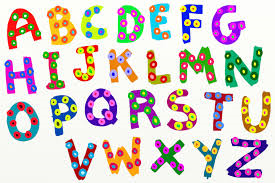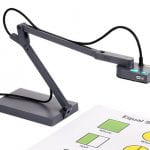by C. Elkins, OK Math and Reading Lady
How do you go about teaching your online students about the alphabet and letter sounds when you can’t be with them in person? That is the topic of today’s blog. By no means do I have all the answers, so please chime in with your ideas too!
In an actual classroom, your students would have opportunities to manipulate and sort objects by letter or beginning sound, to write under your watchful eye and guidance, to find the letter used in actual text, and experience fun learning center-type activities to immerse themselves. Maybe it’s not as hard as you think — below are some possible teaching strategies (and some FREEBIES) you can use with your students to help teach the letter sounds and alphabet. By all means, ensure this instruction is a regular and systematic part of your teaching routine.
 Before I go on, one important piece of equipment in case you are working from home and not at school would be a document camera. I know from my experience that physically holding something up to the camera for a student to see isn’t always a good idea. For one thing, it covers your face. It wiggles when you hold it. It can appear backwards (unless you uncheck “mirror my video” if using Zoom). While the type of document camera purchased for your classroom is likely too costly for home use, there are many small portable ones (see Amazon) in the $100-200 price range that connect to your device via a usb port. With their downloaded software you will be in business! I use one from Ipevo which I love!
Before I go on, one important piece of equipment in case you are working from home and not at school would be a document camera. I know from my experience that physically holding something up to the camera for a student to see isn’t always a good idea. For one thing, it covers your face. It wiggles when you hold it. It can appear backwards (unless you uncheck “mirror my video” if using Zoom). While the type of document camera purchased for your classroom is likely too costly for home use, there are many small portable ones (see Amazon) in the $100-200 price range that connect to your device via a usb port. With their downloaded software you will be in business! I use one from Ipevo which I love!
My document camera has been crucial to online teaching. It allows me to show strategies in real time, read text together, play games, show pictures, etc.
- Alphabet cards: Cards that are colorful and a good size to show students under your document camera are essential.
- Present when teaching the letter / sound for the first time. Show how to form the letter. Use cards easily for frequent review. These are like the type you might have posted on the walls in your traditional classroom.
- Here is an editible FREE set from TPT. Editable alphabet cards with pictures While the pictures shown are very good, I did notice on the vowels some of them are using a picture to represent the short sound (apple, elephant, umbrella) while some pictures represented the long sound for the vowel (ice cream, orange). In some cases, this would prevent me from getting the set — but it’s FREE and you can edit it to change the picture. Or better yet, for the vowels show 2 pictures (1 to represent each sound).
- Here is another set from a TPT author who is very early-childhood friendly and has a ton of good free stuff (you may have to join her blog to get access to the free stuff). I like her alphabet cards because they have a few pictures to accompany each letter. https://thisreadingmama.com/mega-pack-free-phonics-cards/
- Alphabet – how your mouth should be formed:

O says /o/ like this:
This is a critical aspect of teaching letter sounds. It matters how the lips, teeth, and tongue are coordinated to produce the sound. For example, many young children have difficulty with /l/ and can often be corrected by physically showing them where to place the tongue (behind the front teeth). You can show them how their lips, etc. should look with each letter. It’s ok to exaggerate a little bit. And by all means, when working on the next item in my list (video), make yourself visible so they can see how to form the letter with their mouth and you can check via your screen if the child is forming their mouth correctly.
- Alphabet videos: I am sure most all of you have used videos from youtube for your students. Here is the one I recommend because of the repetition of the letter sound and pictures starting with that sound. In each video (devoted to only one letter at a time) the student gets dozens of opportunities to say the sound and objects with background music that is motivating to get children to participate. Here’s one for the letter Mm: “Have Fun Teaching” Letter M /m/ video on Youtube
- Alphabet pictures: With a document camera, showing pictures (or real items) with the beginning sound you are teaching is easy. Here’s a set (6 b/w pictures for each letter) that can be sent to students to put together as a mini book for each letter, or printed and cut apart for you to use for teaching. A Dab of Glue Will Do (Blog) Free alphabet booklets The word is printed with each picture making it easy for you to point to the first letter for emphasis.
- Alphabet writing: If your online students have a whiteboard, you can use your document camera to model how to write the letter, let them practice, and then hold up their board to show you.
- Alphabet in text: It is super important to include opportunities to see the letter you are working on in text. I recommend using the child’s name, class member names, easy patterned text, or short poems. Show the text under your document camera or pull up from a licensed site you have access to. Have students find the letter wherever it appears in the text. This shows students how letters are being used.
- Alphabet sorting and review: Using pictures (like from #4 above), you can show a picture (cover the word though) and have students name the letter, hold up a letter tile, or write the letter on their whiteboard to show you. You can also display 2-3 letters (magnetic, tiles, or written in column form on a whiteboard) and help students sort pictures by telling you where to place them. This is also a good video to review all of the letter names, sounds, and pictures/words with that beginning sound: Jack Hartman Alphabet song
- Alphabet practice: There are a lot of resources you may already have that can be transformed to a digital format via boom cards or Seesaw, etc. Some teachers also print up packets at school for weekly distribution to parents (worksheets, cut-n-paste, sorting), and these could be included as supplmental to your online teaching.
Finally, please read this Alphabet research I summarized. Alphabet Letter and Sounds Research (C. Elkins Edublog) Very eye opening and beneficial in my opinion. You will come to understand why children get confused with learning the alphabet. Example: “F” is pronounced with a short vowel sound before the letter /ef/ while “J” is pronounced with a long vowel sound after the letter /jay/. “Double you” = /w/. “Aych” = /h/. You will find a great 1 page teaching template for teaching letter sounds which focuses on aspects I mentioned above (Here is the letter, here’s how it sounds, here’s how to write it, here it is in text).
Take care! Hope you are all well and safe. Looking forward to your comments!